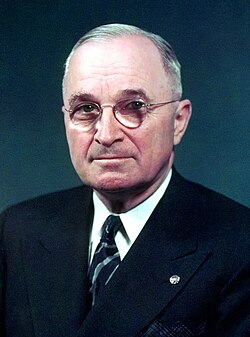The final leaders of the Allies at the Potsdam Conference in 1945: Clement Attlee, Harry S. Truman, and Joseph Stalin.
US President Franklin D. Roosevelt and British Prime Minister Winston Churchill during the Casablanca Conference, January 1943.
Chiang Kai-shek, Roosevelt, and Churchill at the Cairo Conference, 25 November 1943.
The Allied leaders of World War II listed below comprise the important political and military figures who fought for or supported the Allies during World War II. Engaged in total war, they had to adapt to new types of modern warfare, on the military, psychological and economic fronts.
Contents
- Free Albania
- Kingdom of Belgium
- Brazil (1942–1945)
- British Empire and Commonwealth
- Australia
- Canada
- New Zealand
- British Raj India
- Union of South Africa
- United Kingdom of Great Britain and Northern Ireland
- Republic of China
- Republic of Cuba
- Free Czechoslovak Republic
- Kingdom of Denmark
- Kingdom of Egypt
- Ethiopian Empire
- French Republic
- Free French Forces (and later Fighting France and Provisional government of the French Republic)
- Kingdom of Greece (1940–1945)
- Imperial State of Iran (after Anglo-Soviet Invasion)
- Provisional Government of the Republic of Korea
- Republic of Liberia
- Grand Duchy of Luxembourg
- Mexico (1942–1945)
- Mongolian People's Republic
- Kingdom of the Netherlands (1940–1945)
- Kingdom of Norway
- Second Polish Republic
- Polish Government in Exile and Secret State
- Soviet Union (1941–1945)
- United States (1941–1945)
- European and North African Front
- Pacific Front
- Puerto Rico
- Commonwealth of the Philippines
- Kingdom of Yugoslavia
- Vietnam
- Viet Minh
- Vanguard Youth
- Anti-Japanese Catholic forces
- Bình Xuyên
- See also
- Notes
- References






























